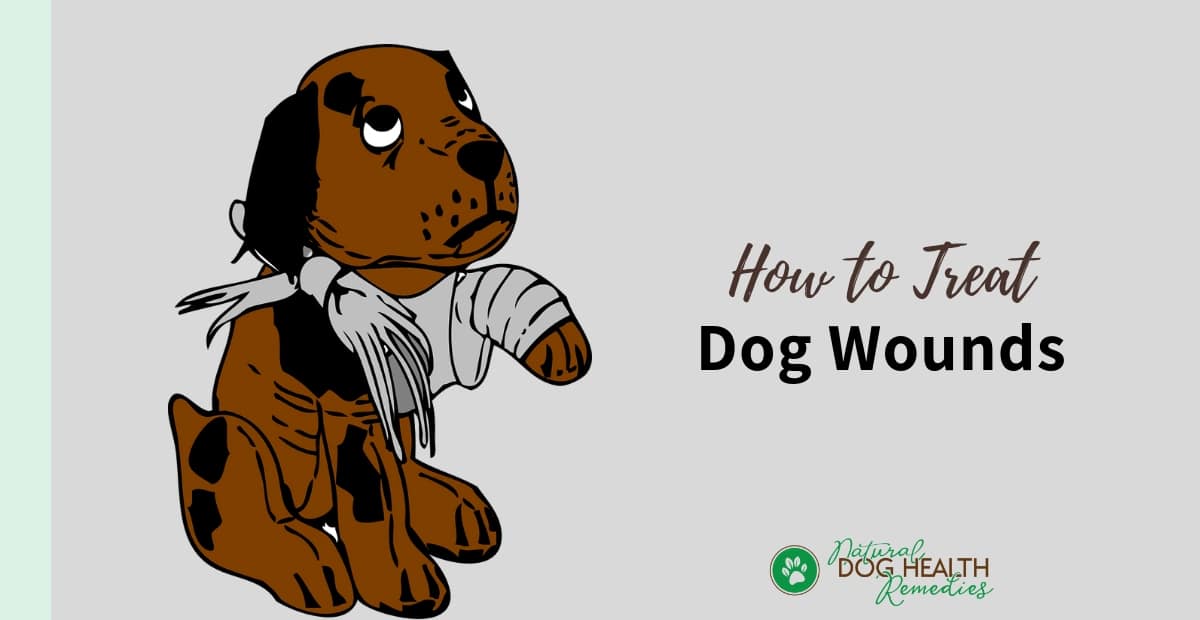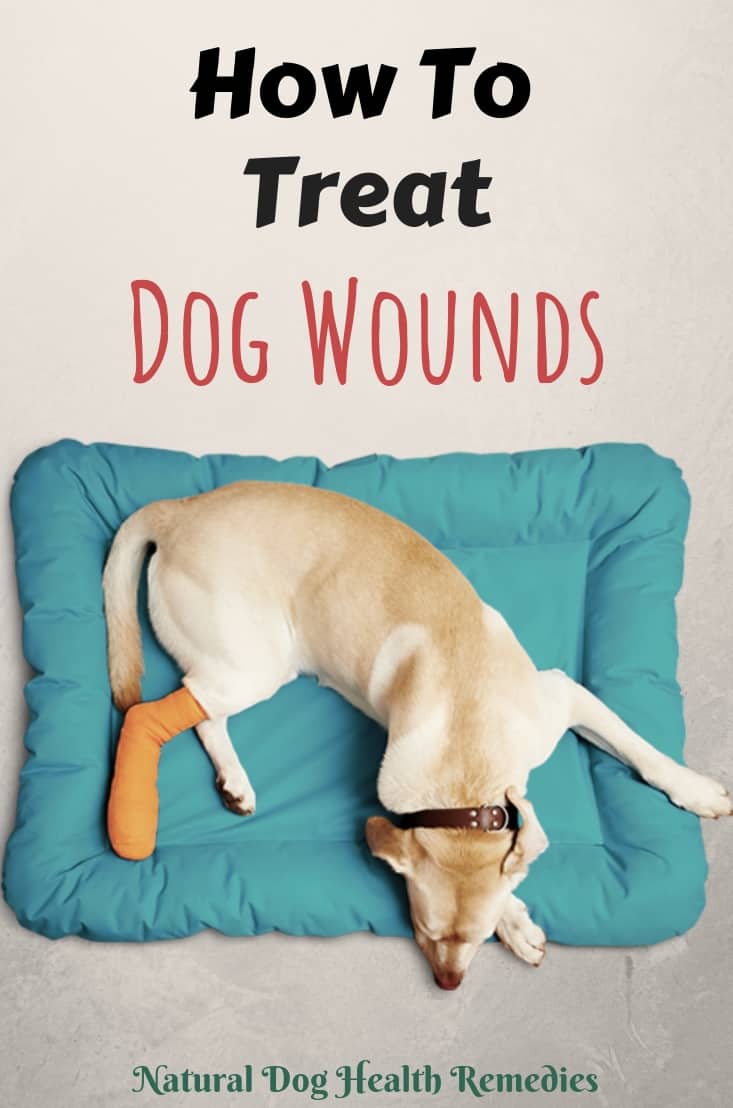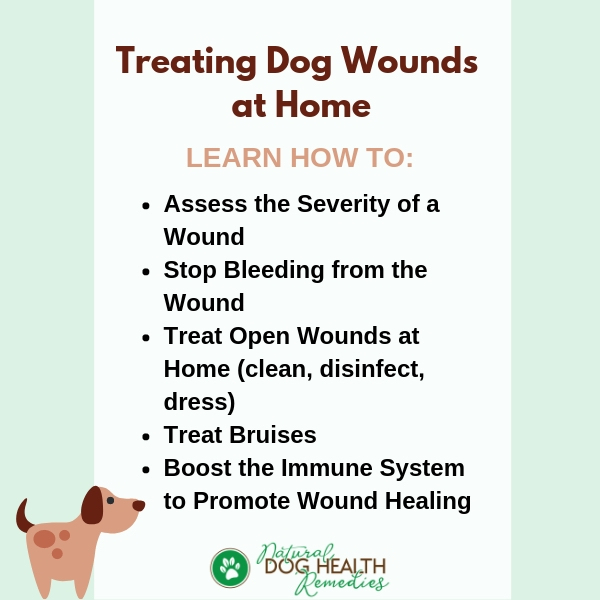Treating Dog Wounds
(FTC Disclosure: If you make a purchase via a link on this page, I may receive a small commission, at no added cost to you.)

Overview
Wounds can be classified as either open (i.e. a break in the skin) or closed (e.g. a bruise).
The skin protects your dog's body from toxins and bacteria from entering his body. But when your dog is wounded and the skin is broken, even if just a small area, bacteria and other harmful organisms can gain access into the body, causing infection.
It is therefore important to learn how to treat dog wounds.
This page looks at:
- How to Assess the Seriousness of a Wound
- How to Stop Bleeding
- Treating Dog Wounds at Home
- Treating Bruises
- Boosting the Immune System to Promote Wound Healing
How To Assess a Dog Wound
- Bleeding: If your dog has an open wound, chances are he is bleeding. The first thing to do is to determine how serious the bleeding is and whether a trip to the emergency veterinary clinic is necessary.
In general, if you see a wound that is spurting blood or the blood is coming out in pulses, it is extremely serious and you should get your dog to the emergency veterinary clinic immediately.
If blood is flowing or dripping out from the wound, the bleeding is still considered to be very serious and again, an immediate trip to your vet is necessary.
If blood is oozing or seeping out, the wound is usually not so deep and can be treated at home.
- Discharge: Take a look at the wound. Is there a pus-like discharge? If there is, it shows that the wound is infected, and veterinary attention is necessary.
- Size: How big is the open wound? And how deep? If it is just a surface scrape or a minor small cut, you can most likely treat the wound at home. Anything bigger or deeper than that should be looked after by a vet.
- Other Conditions: Also, don't forget to observe other conditions that your dog is showing. For example, is he in great pain (whining, not allowing anyone to even get close to the wound)? Do you see signs of lethargy and weakness? Is the dog shaking? If your dog is showing some of these signs, he is probably distressed and in pain, and you should take him to the vet immediately.
How to Stop Bleeding from a Wound
If your dog is bleeding profusely, you need to try to stop (or at least slow down) the bleeding while on your way to the vet. If you are driving, ask someone to attend to the dog.
To stop bleeding from a wound, apply direct pressure with a sterile gauze pad or a clean towel.
Some people tend to keep lifting the towel or gauze to check on the wound and the bleeding.
Don't! Otherwise, it will be difficult for the blood to clot. Similarly, DO NOT remove the towel or gauze even if it is soaked with blood. Just continue to add more gauze or towels on top of the soaked ones.
You should also elevate the bleeding source so that it is above the level of your dog's heart.
For severe bleeding, you need to apply direct pressure to the arteries that supply the wounded area. These pressure points are located at the upper inside (armpit) of the front legs, the upper inside of the hind legs and the underside of the tail.
Only use a tourniquet as a last resort or on the advice of a vet or human doctor.
Treating Open Dog Wounds At Home
If you can determine that your dog's wound is not so serious as to warrant a trip to the vet, try treating the wound at home as follows.
Clean the Wound
 Clean the wound once bleeding has stopped.
Clean the wound once bleeding has stopped.
First, use a pair of scissors to trim the hair surrounding the wound. Dipping the scissors in mineral oil before cutting the hair will cause the hair to stick to the scissors instead of falling into the wound.
Be very careful with the scissors so you don't cut the skin accidentally. Ask someone to restrain the dog if necessary.
If hair trimming is made difficult by crusted blood and debris on the wound, try to soften this material with warm water and soft toweling. Blot the area gently.
Once the hair has been trimmed and the entire wound revealed, flush it well with warm distilled water or a sterile saline solution.
Pat dry the wound.
Disinfect the Wound
Next, disinfect the wound using a mild antiseptic. I find these Chlorhexidine antiseptic wipes very handy.
Alternatively, get a Chlorhexidine 2% solution. Put some on a piece of sterile gauze and use it to disinfect the wound.
Dress the Wound
Next, to further facilitate clotting of blood on the wound, you can try using either of the following herbal remedies:
1. Calendula: Spread a thin coat of calendula ointment on one side of a non-stick pad and apply it directly to the wound.
2. Yunnan Baiyao: This is a Chinese herbal powder that is commonly used to stop bleeding (both externally and internally). Just sprinkle some of the powder non-stick pad and apply it directly to the wound.
Using a roll of cotton gauze or bandage, trap the pad against the skin and wrap the gauze around the body part in a manner that will keep the pad in place.
Be careful not to wrap the gauze too tightly, otherwise blood circulation will be cut off. Changing the bandage once a day and keeping the wound clean will help the healing.
Treating Bruises
If dog wounds are accompanied by a lot of bruising (such as in bite wounds), use the homeopathic remedy Arnica to ease the bruises. It is very effective. Just give your dog two pellets of Arnica (30C) once or twice on the day of the injury.
Boosting the Dog's Immune System
To help you dog's wound heal properly, consider supplying him with extra nutrients to boost his immune system. Here is what you can give to your dog:
- Echinacea: Echinacea is an effective immune-boosting herb. You can get a tincture of the herb and give your dog five drops per ten pounds, two to three times a day.
- Vitamin C: Vitamin C is an immune-booster as well as an antioxidant. It can also prevent infections. Give your dog about 5-10 mg/pound, two to three times a day for two to five days.
- Pancreatic Enzymes: Pancreatic enzymes such as Prozyme can help your dog digest his food more thoroughly and get more micronutrients into the bloodstream to help replenish the blood loss as well as to help the body fight infection.

Do You Have a First Aid Kit for Your Dog?
Dogs are curious and could sometimes get injured or into trouble as a result. It is therefore important to have a first aid kit for your dog. If you are unsure as to what to put in a dog first aid kit, see this page for suggestions.
Eldredge, et al. Dog Owner's Home Veterinary Handbook 4th edition (Wiley Publishing, 2007).
Merck Publishing and Merial. The Merck/Merial Manual for Pet Health (Merck, 2007).
M. Goldstein, The Nature of Animal Healing (Ballantine Books, 2000).
R.H. Pitcairn, The Complete Guide to Natural Health for Dogs and Cats (Rodale, 2005).





